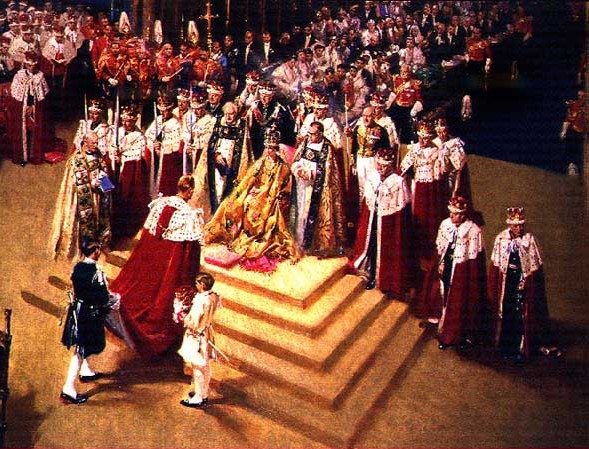
Monarchy
New Zealand
The Journal of The Monarchist League of New Zealand Incorporated
ISSN 1174-8435


Volume 8 Issue 2 May 2003

The Monarchist League of
New Zealand, Inc.
Patron: Hon Sir Peter Tapsell, KNZM MBE MBChB FRCSEd FRCS
The Secretary, 72F Ladies Mile, Remuera,
Auckland 1005, New Zealand
Website URL: http://www.geocities.com/Capitolhill/Parliament/7802
Council:
Chairman: Noel Cox, Esq., LLM(Hons) PhD GradDipTertTchg AdvCertHeraldrySociety CertTertTchg HonCIL FCIL FFASL FBS
Vice-Chairman: Merv Tilsley, Esq.
Secretary: Chris Barradale, Esq.
Treasurer: Stephen Brewster, Esq., MBA BCA CA
Councillors:
Nicholas Albrecht, Esq., MA(Hons)
Roger Barnes, Esq., FHSNZ
John Cox, Esq., LLB MNZTA
Neville Johnson, Esq.
Ian Madden, Esq., MA LLB FSA(Scot)
Robert Mann, Esq., MSc PhD
Professor Peter Spiller, BA LLB PhD LLM MPhil PhD AAMINZ
League Officers:
Legal Adviser: Noel Cox, Esq., LLM(Hons) PhD GradDipTertTchg AdvCertHeraldrySociety CertTertTchg HonCIL FCIL FFASL FBS
Librarian and Archivist: Noel Cox, Esq., LLM(Hons) PhD GradDipTertTchg AdvCertHeraldrySociety CertTertTchg HonCIL FCIL FFASL FBS
Provincial Representative, Wellington: Mathew Norman, Esq., BA
Provincial Representative, Manawatu-Horowhenua: Kevin Couling de St Sauveur, Esq.
Editor, Monarchy New Zealand: Noel Cox, Esq., LLM(Hons) PhD GradDipTertTchg AdvCertHeraldrySociety CertTertTchg HonCIL FCIL FFASL FBS
Assistant Editor and Advertising Manager, Monarchy New Zealand: John Cox, Esq., LLB MNZTA
Honorary Chaplain: Revd Canon Gerald Hadlow, LTh
Webmaster: Noel Cox, Esq., LLM(Hons) PhD GradDipTertTchg AdvCertHeraldrySociety CertTertTchg HonCIL FCIL FFASL FBS
Monarchy New Zealand is published by The Monarchist League of New Zealand Inc. Opinions expressed do not necessarily reflect the policy of The Monarchist League of New Zealand. Correspondence should be addressed to the Editor, Monarchy New Zealand, 123 Stanley Road, Glenfield, Auckland 1310, New Zealand. Tel: +64 9 444-7687; Fax: +64 9 444-7397; E-mail: [email protected]
Editorial
Monarchy is inherently hereditary in nature. Even those hybrid federal monarchies, the United Arab Emirates and Malaysia, are founded on the principle of selection of the head of state, not by political process or election, but by inheritance. Whether we see this as a means of acquiring a truly non-partisan sovereign, or as an invitation for divine intervention, the effect is common around the world. The Sovereign is chosen by accident of birth.
This may be obvious enough, but it is important to emphasize, for with the process comes the corollary that the accession of one sovereign follows the death of their predecessor. As the accession proclamation of Her Majesty The Queen stated, "Whereas it has pleased Almighty God to call to His Mercy our late Sovereign Lord King George the Sixth, of Blessed and Glorious memory, by whose Decease the Crown is solely and rightfully come to the High and Mighty Princess Elizabeth Alexandra Mary".
The Queen had no more choice in the matter than did her father. On the demise of the Crown – in the case of King Edward VIII by abdication (an extremely rare occurrence for a British sovereign, and extremely destabilising) – usually on the death of their parent, the heir to the throne automatically becomes sovereign. "The King is dead, long live the king," is an axiom as accurate as it is well known.
A direct – and unavoidable – consequence of this is that the public have no say in who becomes Sovereign. Parliament can and does change the laws of succession from time to time, normally in response to political circumstances, as when the Act of Settlement excluded Roman Catholics to prevent them re-imposing that religion upon the largely unwilling British people. However the changes are not retrospective.
With the reduction in the political role of the sovereign, it would be hard to foresee circumstances in which it was again necessary to alter the succession laws to achieve a political objective. The prohibition on Roman Catholics may at some time be removed – it is certainly not something which the royal family themselves sought, and they would not oppose its removal.
A danger lies in the tendency over recent years to question the right of the Prince of Wales to succeed. The institution of monarchy does not require that the king or queen be a paragon – least of all in modern times, when their individual political role is minimal. It may not be too far from the truth to say that a reasonably competent, or even just conscientious, king will be a good king. The heir has never been denied the Crown on the basis of their personal attributes. To advocate this would be to misunderstand the nature of the office.
If an heir or heiress were totally unfit for their responsibility special provision would doubtless be made for such a situation, just as the minority of kings is met with the use of regencies.
The present Prince of Wales is hardly in such a position. He has laboured for years at a task for which he seldom receives any thanks. Like his mother The Queen he has a strong sense of duty. He knows that his is a lonely destiny, but it is not one which he regards as optional.
One of the comments often made by dedicated republicans is that they have enormous respect for the Queen and would not wish to push for a republic during her lifetime. Where does that leave the Prince of Wales? He will become king on the death of The Queen. Whether that will be sooner or later none can say.
Attacks upon the Prince of Wales are attacks on the institution of monarchy. Were a prince – or anyone else – guilty of an offence, they would have to face the consequences. But the Prince of Wales has been repeatedly condemned for the actions of his staff, for his appearance, for the death of his wife, and for a multitude of other things, real and imagined, for which little or no blame should attach to him.
Who bothers to recall that Prince Charles has established and takes an active part in running the Prince’s Youth Business Trust, Business in the Community, Prince of Wales’s Business Leaders Forum, The Prince’s Foundation for Architecture and the Urban Environment, The Prince’s Trust, and other organisations?
No-one is perfect, but the Prince of Wales has seldom been given the credit he is due. To suggest that he is somehow unfit to be king is a nonsense, insulting, and quite misguided.
Dr Noel Cox
Editor
News in Brief
Jubilee coin
New Zealand Post, on behalf of the Reserve Bank of New Zealand, has issued a Golden Jubilee Coin.

The sterling silver and 22-carat gold coin, in a royal purple velvet case, has been produced to commemorate the 50th anniversary of Her Majesty Queen Elizabeth II’s accession to the Throne in 1952. Unique to New Zealand and available for a limited time only, the coin is a fitting tribute to a long and distinguished reign.
The collector coins, which are issued as legal tender – but do not circulate – are only available from New Zealand Post’s Stamps Business.
Queen Elizabeth – and the Monarchy itself – are an essential part of New Zealand’s heritage and our place in the Commonwealth. The Jubilee offers us an opportunity to look back at the central role Her Majesty has played in the Commonwealth over the past 50 years, and to look forward to the Monarchy’s place in the future of this association of sovereign states.
To commemorate The Queen’s Golden Jubilee, the British Royal Mint has established a dedicated coin programme for 12 countries in the Commonwealth. Each has developed its own design to honour this distinguished and much-admired Monarch.
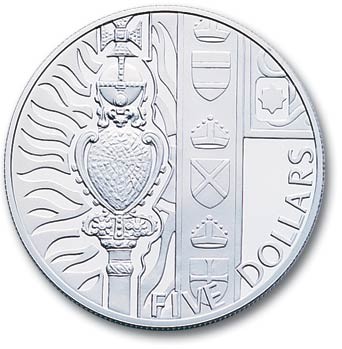
New Zealand’s commemorative silver-frosted proof $5 coin depicts an image, designed by Robert Lowe, of the Sceptre with the Cross. A revered symbol of Royal authority and a key part of the Coronation ceremony and Royal regalia, the Sceptre symbolises The Queen’s temporal power over her people. It is dominated by the fabulous Great Star of Africa – the world’s largest cut diamond when set into the Sceptre in 1910.
The coin’s obverse, designed by Ian Rank-Broadley, features The Queen’s portrait in sterling .925 silver, highlighted in 22-carat gold.
Weighing just under 30 grams, this timeless reminder of a once in a lifetime event will be a much treasured addition to any collection.
Coin Specifications:
Denomination: $5
Finish and Composition: Frosted proof, Sterling .925 silver with The Queen’s portrait highlighted in 22 carat gold
Weight: 28.28gms
Diameter: 38.61mm
Obverse Design: Ian Rank-Broadley, England
Reverse Design: Robert Lowe
Issue Limit: Worldwide maximum of 25,000
Mint: Royal British Mint
Cost: $120 plus $5 postage (New Zealand)
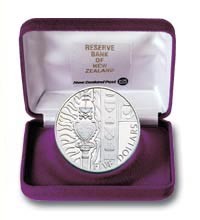
To order:
NZ Post Stamps Centre
Private Bag 3001
Wanganui
Phone: (06) 349-1234
Fax: (06) 345-7120
E-mail: [email protected]
Internet: http://www.stamps.co.nz
VC and GC memorial
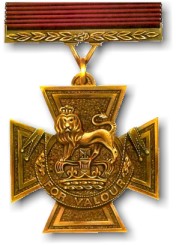
A memorial to the recipients of the Victoria Cross and the George Cross is being built in Westminster Abbey. The memorial, the first of its kind, was announced 29th May 2001 by the Very Revd Wesley Carr, MA PhD, Dean of Westminster. An appeal for funds for the memorial was launched at the Imperial War Museum, London, by Admiral Sir Alan West, KCB DSC, First Sea Lord and Chief of Naval Staff, in November last year.
The memorial is to be dedicated on 14th May this year. It is of a simple design, the two decorations being depicted in bronze and silver, and with enamel ribbons. The bronze used is not that of the original Russian guns captured at Crimea, which is used to cast new VCs, and of which enough remains for a further 83 medals. An inscription on the memorial reads "Remember their valour and gallantry". The memorial is inlaid in the paving near the Tomb of the Unknown Soldier at the west end of the Abbey.
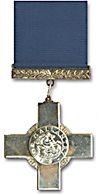
Contributions for the memorial may be sent to The Victoria Cross and George Cross Memorial Appeal, Horse Guards, Whitehall, London SW1A 2AX, United Kingdom. A total of £250,000 is required.
Coronation anniversary service
A Service to mark the 50th anniversary of the coronation will be held at Holy Trinity Cathedral, Parnell, Auckland, on Sunday 15th June. It will commence at 5 pm.
On the evening of Sunday 8th June there will be a Monarchist League dinner in Auckland to celebrate the 50th anniversary of the coronation of Her Majesty The Queen.
The venue is the Crown Plaza Hotel, the time 7 pm for 7.30 pm.
For bookings and further information, contact John Cox, phone (09) 489-3188 (office hours), or (09) 444-5946 (after hours), or email [email protected]
Privy Council
Submissions to the Justice and Electoral Select Committee on the Supreme Court Bill have closed. Due to public interest the deadline for submissions was extended by two weeks.
The select committee chairman Tim Barnett has called for comments to be made on whether the right of appeal to the Privy Council should be abolished, maintained or extended. He also called for comments on whether, if appeals were abolished, New Zealand should consider forming an international appeal court available not only for New Zealand, but also for other South Pacific or Commonwealth countries.
Comment was also sought on the question of what shape it should take, if such an appeal court was established. The Select Committee chairman also asked for comments on how, and to what extent, the proposed Supreme Court could be adapted to meet that international role.
It has always been the Monarchist League’s position that the proposed abolition of the right of appeal to the Privy Council was motivated in part by republicanism. For this reason the League has been active in opposing the Bill.
A large majority of the legal profession are opposed to the abolition of the Privy Council. This was vividly demonstrated in May by the annual general meeting of the Auckland District Law Society voting unanimously in favour of retaining appeals to the Judicial Committee of the Privy Council.
The Queen’s Commonwealth Day address
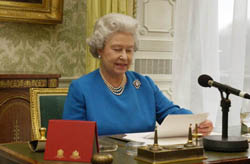
The following is the Queen’s Commonwealth Day address for 2003:
Among my cherished memories of my Jubilee celebrations last year were those connected with the Commonwealth – in particular the visits to Jamaica, New Zealand and Canada. There was also the undoubted success of the 2002 Commonwealth Games in Manchester – both as a great sporting and Commonwealth occasion, and as a tremendous expression of the host city’s community spirit. Launching the Baton Relay from Buckingham Palace on Commonwealth Day last year was one of the many colourful events leading up to the Games.
A few days before, I had opened the 2002 Commonwealth Heads of Government Meeting in Coolum, Australia. That summit charted a new course for the Commonwealth, confident of the important contribution the association can play as a force for good in the world.
What we have in common makes the choice of this year’s theme for Commonwealth Day, ‘Partners in Development’, so fitting. We are reminded daily that we live in an interdependent world. And yet there exist great global inequalities, with millions living lives of deep poverty and deprivation, which present a great and constant challenge to the notion of the Commonwealth. Under these conditions, peace is often more difficult to sustain while precious natural resources and the environment are threatened, economic growth and activity may be impeded as well as the benefits of modern technology denied to many.
Working in partnership is essential if the nations of the earth, whether they be developed or developing, are to build a better, more secure and more sustainable world. Only together can governments and peoples create just, open and democratic societies. And through a sense of partnership and mutual respect we should be able to recognise that we all share a common humanity, regardless of who we are or where we may be from.
In all this, the Commonwealth has much to offer. It is a unique global grouping, spanning every region of the world and including in its membership countries of all sizes and stages of development. It is an association of peoples as well as governments and, as we particularly celebrated last year, it is a body which values the richness of its diversity. The special role of the Commonwealth in development was spelt out once again in the Coolum Declaration and at the meeting of the Commonwealth Finance Ministers in London last September.
2002 was for me a special year – and it was also an opportunity to recall those elements of my life, notably the Commonwealth, which have been of enduring importance. Appreciating just how far the Commonwealth has developed in the last fifty years is surely a cause for great hope in the future.
Elizabeth II
Royal Diary
The Queen Mother’s patronages assumed by the Prince of Wales
The death of Her late Majesty The Queen Mother temporarily deprived a large number of charities of royal patronage.
The Prince of Wales has now assumed 21 patronages formerly held by The Queen Mother. These are the Aberdeen Angus Cattle Society, Ballater Royal Horticultural Society, Battle of Britain Fighter Association, British Red Cross Society, Caithness Agricultural Association, Caithness Heritage Trust, Chelsea Physic Garden, Combat Stress, The Garden Society, Georgian Group, Marie Curie Cancer Care, The National Garden Schemes, National Poultry Club, The National Trust, The National Trust for Scotland, Royal Scottish Academy of Music and Drama, Royal Scottish Society of Painters in Water Colours, Salmon and Trout Association, Keats-Shelley Memorial Club, The Society for the Protection of Ancient Buildings, and the Victoria Cross and George Cross Association.
Her Majesty The Queen has succeeded The Queen Mother, as President of the Sandringham Women’s Institute, of which she has been a member from 1943.
League News
Queen’s Birthday Service
The Vicar, Parish of Takapuna, the Revd Richard Hancock, in conjunction with the Monarchist League, will hold the annual Queen’s Birthday Service at St Peter’s Church, Killarney Street, Takapuna, on Sunday 1st June.
The Service, which commences at 10 am, will be followed by refreshments provided by the League, in the adjoining St Peter’s Church hall.
Local members of the League are encouraged to attend the Service, and join in marking this annual royal occasion. Members living outside the North Shore are again reminded that they should encourage their local churches to mark The Queen’s official birthday.
Annual General Meeting
The 2003 Annual General Meeting of The Monarchist League of New Zealand Inc will be held at 2 pm on Sunday 18th May 2003 at the International Seafarers’ Centre, 114 Quay Street, Auckland. This will be preceded by afternoon tea, from 1 pm, for which a donation of $5 is requested. There is no charge for those attending the AGM only. A notice of the Annual General Meeting is enclosed with this journal.
Candidates are now being sought for election to the Council. Nominations, which are to be in writing, signed by the nominee and another member of the League, should be received by an officer at least three days prior to the Annual General Meeting. The Secretary can arrange for nominations to be signed where a member does not have ready contact with another member.
Overseas News
The 50th anniversary of the coronation – some contemporary regalia

In this, the 50th year since Her Majesty’s coronation, it is worth looking at some of the Crown Jewels which played a part in that ancient ritual. But this article is not concerned with the regalia fashioned for King Charles II, or those surviving from earlier times. This article is about the regalia specially commissioned, or refashioned, in 1953.
The first item is the armilla, also known as the robe royal, pall of gold, or simply the stole. It is worn about the Sovereign’s neck, uncrossed, over the supertunica. The Liber Regalis (1307) requires its use, although it has only been used since King James I.
The royal stole was derived from the loros, (loros) a jewelled scarf of the eastern emperors. Senators and consuls were required to wear a coloured pall or scarf over the alb and paenula by the sumptuary Codex of Theodosius (382). The stole as a liturgical vestment is confined to the higher orders of the Christian ministry – deacons, priests and bishops.
The present royal stole was newly made for the Queen in 1953, and presented by some of the Commonwealth countries of which she was Queen. It is now kept in the Tower of London.
The stole is a richly and heavily embroidered cloth-of-gold scarf, with gold and silver thread and set with jewels. It has a square panel at either end each with a red St George’s Cross on a silver background. On a background of floral emblems of the Commonwealth are the emblems of the four Evangelists. There are also St Edward’s Crowns, imperial eagles, and the dove of the Holy Ghost, as well as the flags of St Patrick, St Andrew and St George. The lining is of rose-coloured silk, and there are gold fringes at each end. The overall measurement is 5’ by 3".
The Armills are known as the bracelets of sincerity and wisdom. Armills were included among the new regalia made for Charles II, but were not worn at his coronation. They were however used by King James II. Later Sovereign’s did not wear them at coronations because of confusion about their purpose. They were sometimes confused with the Armilla, or Stole. They were however displayed at subsequent coronations, and were re-enamelled for the coronation of George IV.
The Commonwealth presented a new set of Armills to the Queen in 1953. These were worn at a coronation for the first time in almost 300 years. These were made in 22 carat gold by Garrard’s, the present Crown Jewellers. They are lined with crimson velvet.
The best known of all the crowns, the present Imperial State Crown was originally made for Queen Victoria’s coronation in 1838 by Rundell, Bridge & Rundell, the Crown Jewellers. It is worn by the Sovereign on the return from Westminster Abbey after the Coronation. The Imperial State Crown is also worn by Queen Elizabeth II for her speech at the annual State Opening of Parliament in London.
The crown was entirely rebuilt – following the original pattern – for King George VI by Garrards in 1937, and the arches were lowered for Queen Elizabeth II in 1953. The crown is of traditional design of crosses patteé and fleurs-de-lis with four half-arches of oak-leaf design set with pearls and diamonds. It is fitted with a purple velvet cap turned over with ermine and is mounted in gold and silver. The frame itself is of platinum. The crown weighs 2 pounds 13 ounces and is set with over 3,000 precious stones.
The most important stones are St Edward’s Sapphire, set in the cross pattée above the monde, Queen Elizabeth I’s Pearls are suspended below the monde, the Black Prince’s Ruby (a spinel) in the cross pattée above the band, and the Stuart Sapphire in the band at the back. Originally the Stuart Sapphire was in the front. Another sapphire (still in the Jewel House) was at the back. The Second Star of Africa (Cullinan II) replaced the Stuart Sapphire (which was moved to the back) in 1909.
A sword belt (also called girdle or cincture), worn with the supertunica, was presented by The Girdlers Company 1953.
The Queen Mother’s Crown
was the only crown fully mounted in platinum. It was created by
Garrard for the Queen consort at the coronation in 1937. 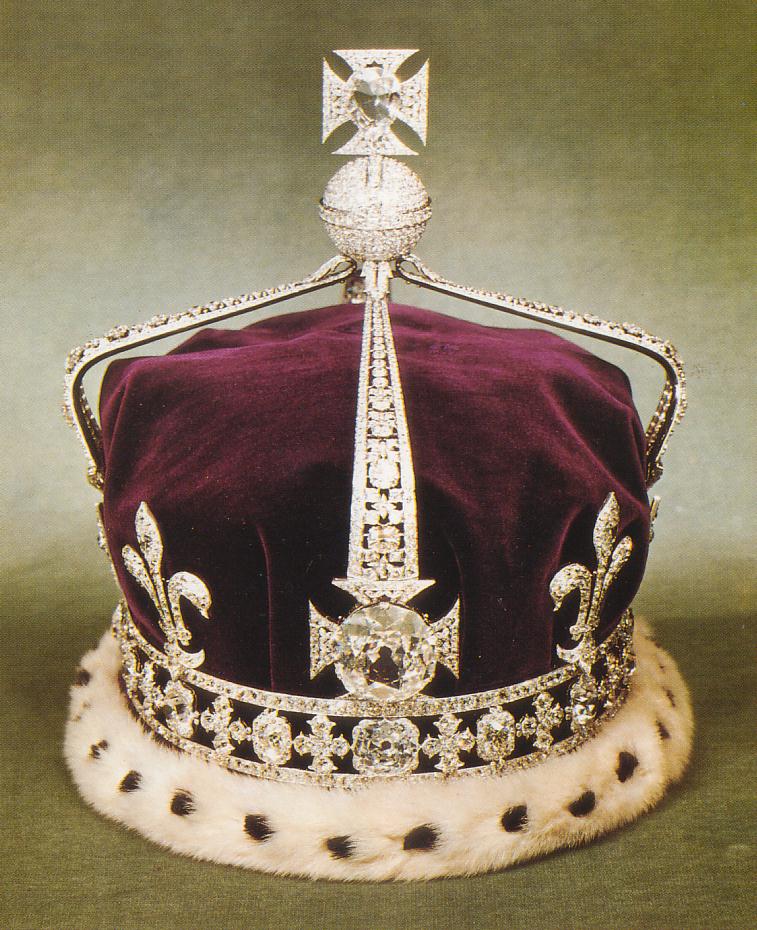
It is of traditional design, consisting of four crosses pattée, four fleurs-de-lis, four half-arches, a monde and a cross. It can be worn as a circlet with the arches removed and The Queen Mother wore it this way at the Coronation of her daughter in 1953.
It has over 2,800 diamonds, the best known of which are the Koh-i-Noor, set in the front cross pattée, the Lahore diamond (now replaced by a crystal) at the centre of the cross, and a large 17.34-carat diamond at the centre of the band at the front which came from a stomacher given to Queen Victoria by the Sultan of Turkey.
The Lahore diamond came to England with the Koh-i-Noor in 1850 after the annexation of the Punjab in 1849, and is normally worn by Queen Elizabeth II as a drop necklace pendant, suspended from Queen Victoria’s diamond collet. The crown weighs sixteen ounces and has a purple cap turned over with ermine.
Each of these pieces serves to remind us that the Crown Jewels, like the monarchy it serves, changes over time, sometimes dramatically. It has always been true to its history and to contemporary values. Each generation has left its mark on the Crown Jewels, consistent with a long tradition.
Royal Poetry
The cavalier ballad Hold out, brave Charles, and thou shalt win the field dates from early 1647. King Charles I had been surrendered to the English Commissioners by his erstwhile Scottish supporters. He was conveyed by the Commissioners (a de facto embassy from Parliament) to Holmby House, Northamptonshire, on 16th February 1647. This hopeful and patriotic ballad is also known as Upon His Majesty’s Coming To Holmby.
HOLD OUT BRAVE CHARLES, AND THOU SHALT WIN THE FIELD
1. Hold out, brave Charles, and thou shalt win the field;
Thou canst not lose thyself, unless thou yield
On such conditions as will force thy hand
To give away thy sceptre, crown, and land.
And what is worse, to hazard by thy fall,
To lose a greater crown, more worth than all.
2. Thy poor distressed Cavaliers rejoyced
To hear thy royal resolution voiced,
And are content far more poor to be
Than yet they are, so it reflects from thee.
Thou art our sovereign still, in spite of hate;
Our zeal is to thy person, not thy State.
3. We are not so ambitious to desire
Our drooping fortunes to be mounted higher,
And thou so great a monarch, to our grief,
Must sue unto thy subjects for relief:
And when they sit and long debate about it,
Must either stay their time, or go without it.
4. No, sacred prince, thy friends esteem thee more
In thy distresses than ere they did before;
And though their wings be clip’t, their wishes fly
To heaven by millions, for a fresh supply.
That as thy cause was so betray’d by Men,
It may by angels be restored agen.
A REPLY TO ‘A MONARCHIST AVANT-GARDE’
As avowed supporters of the monarchy we are honour-bound to be proactive in its defence. We should not stand idly by whilst the institution which we cherish is attacked or denigrated. However we must also be wary of engendering controversy or initiating unnecessary public questioning of the future of the monarchy. This could be as damaging as the direct attacks of the republicans.
There is currently no public debate on the monarchy. Occasional comments by the few well-known republicans cannot be considered a debate- or a real challenge to the future of the monarchy. Their reported remarks are generally of a nature that does not deserve a reply, or warrant serious consideration. The eccentric press releases of the Republican Movement in particular are unlikely to be doing their cause any good. The real threats to the monarchy are more insidious. I do not propose to discuss the republican cliques in the news media and Parliament in this article.
I believe that a public debate would politicize the monarchy and inevitably make it a subject of controversy. The referendum campaign in Australia must stand as a warning to us in New Zealand. We cannot be complacent that the monarchy would ultimately prevail in such a contest, and irreparable harm might be caused by even a victorious campaign.
The monarchy survives transient political trends and destructive social forces precisely because it is aloof from day-to-day politics, and is of little practical significance to the daily lives of ordinary people. Whilst there is some risk that the institution might simply disappear through apathy, this is a slight risk. Periodic royal events, including weddings and even funerals, reinforce the hold that the royal family has on the public psyche. However any debate on the future and relevance of the monarchy risks splitting the country, making the institution controversial, and ultimately leading to a republic.
The monarchy is not under direct threat at present. If we as monarchists were to launch a debate on "monarchy versus republic" we would risk bringing about the republic that we abhor. The same invidious result could come from attempts at reforming, modernizing or "down-sizing" the monarchy. The histories of revolutions are paved with the bones of reformers who have been consumed by forces that they have unleashed that prove to be beyond their control. Reform may be the first step to abolition.
It is not reactionary to advocate the status quo. The monarchy is both modern and relevant. It has constantly evolved over more than 1,000 years. Most New Zealanders regard our culture and history as worth preserving. The history of the monarchy goes back much further than New Zealand as a nation. So does our language, laws, and peoples. Aspects of Maori culture are very ancient, and are traceable to early Polynesia. Yet these things are all accepted as part of our indigenous culture. We should not deny the same to our New Zealand monarchy.
Other aspects of the New Zealand body politic and culture are unchallenged, and do not need to be defended- or reformed- to ensure their preservation. They are taken for granted, although closer examination may reveal that support even for so-called "icons" is waning. Sports clubs, including rugby clubs, are a good illustration. They are not as popular as they once were, but no one would suggest outright abolition! They are simply evolving with the changing times- as is the monarchy.
Antiquity is not the only authority for the monarchy. Although it is hallowed by time, it has never been justified on those grounds. The Monarchy is a living, evolving, part of the body politic. Far from ossifying, it has evolved increasingly rapidly since the 1960’s. So much so, in fact, that the mystic surrounding the Crown, and the awe with which the Queen was formerly regarded, have been replaced by a degree of familiarity that it not altogether flattering. The monarchy is represented by real people living 21st century lives. It is neither outmoded nor a colonial relic.
A recent opinion poll confirms that many New Zealanders believe that a republic is inevitable, although they do not necessarily support one. One of the biggest threats to the monarchy is the belief that it is ultimately doomed, however false this belief may be. Interestingly, and most provocatively, it is also clear that younger people are less inclined to believe that a republic is inevitable. It is probably correct to deduce that those older monarchists who believe that our cause is lost are being unnecessarily pessimistic. Monarchies are not inherently outmoded, and have a real and vibrant future. We do not need to be defensive.
There are peripheral elements of the monarchy that are attacked in the British press from time to time. The main technical arguments of the republican press concerns the anti-Catholic provisions of the Act of Settlement, and male primogeniture. Some tabloids have criticised the royal family’s German origins, or seem to harbour nostalgia for a semi-mythical Stuart dynasty. There is however no evidence that any of these details or criticisms of the monarchy cause any concern whatsoever in New Zealand. The continued establishment of the Church in England has occasionally attracted criticism. Disestablishmentarianism has, for obvious reasons, no counterpart in New Zealand. Nor is this an issue that should affect the future of the monarchy.
Repeal of the prohibition on Roman Catholics ascending the throne would not materially alter the succession - at least not for the foreseeable future. There is no evidence that the Act causes dissent amongst Catholics in this country, or indeed in the United Kingdom. Similarly, the abolition of primogeniture would be of little practical effect, and would not alter the succession for at least two generations. As the majority of first-born children within the royal family in the last two hundred years have been male, it is possible that a change to the succession laws would have no effect for a similar period. However a reform would require the consent of 17 governments, and the political will to initiate change in an area that does not excite public interest, and does not promise votes.
New Zealand is not a secular state. There are many daily reminders of this. Sessions of Parliament are opened with prayers, as are local councils. The Anzac Day services that many of us attended last month are essentially religious events. There is therefore nothing incongruous in the Queen referring to God during her public speeches, or indeed in her being styled Defender of the Faith. The Coronation ceremony is a profoundly moving religious and experience. The style of Defender of the Faith does not confer any powers duties or responsibilities, or deny the right of non-Christians their own beliefs.
The Church of England in New Zealand has never claimed special status, or been accorded it. The Queen is not Governor of the Anglican Church in New Zealand. There is no reason for the status of the Church to affect the position of the Crown. They are strictly separate, notwithstanding that the Queen is herself Anglican.
I believe that the monarchy is a creditable and worthwhile institution as it stands. It is not in need of reform, nor should we be advocating debate over its future. As a monarchist I believe that we do not need to re-invent the institution to make it worthy of our support. It should be defended for what it is, and what it represents. We should respond to attacks where appropriate, and encourage education and awareness of the monarchy. We do not need to reform or question the future of the institution, and to do either could unleash republican forces that might ultimately prove unstoppable.
John Cox
Royal visits
The Queen and the Duke of Edinburgh 1963
Her Majesty The Queen and His Royal Highness The Duke of Edinburgh visited New Zealand from 6th-18th February 1963. This was the first visit by Her Majesty since her post-coronation tour, though the Duke of Edinburgh had been to New Zealand in 1956.
The Royal couple were received by the Governor-General, Brigadier Sir Bernard Fergusson. The Prime Minister, the Rt Hon Keith Holyoake, and Minister of Internal Affairs, Frank Götz, were Minister in Attendance and Associate Minister in Attendance respectively.
The Queen and the Duke of Edinburgh visited a number of towns and cities in the course of a twelve-day visit.
After the royal visit Sir Bernard Fergusson was made a Knight Grand Cross of the Royal Victorian Order (GCVO), Keith Holyoake was made a Companion of Honour (CH), and Sir Frank Götz a Knight Commander of the Royal Victorian Order (KCVO).
Administration of the visit was by John Meech (later Sir John, KCVO), Secretary of Internal Affairs, who was New Zealand Secretary to The Queen. He was Director of Royal Visits 1959-67, and this visit was to form a model for the administration of subsequent royal visits.
Royal Residences past and present
Leeds Castle
Leeds Castle, at Maidstone, Kent, is one of the most distinctive of English castles. It was owned by many Kings and Queens since Queen Eleanor of Castile in 1278. The Manor of Leeds, to which the castle belongs, is even older, having belonged to Ethelbert, later King of England, in the year 856.
The castle served as a dower house for eight queens, including Isabella consort of Edward II, Joan, queen of Henry IV, and Eleanor of Gloucester. The last royal owner was King Edward VI (1547-52), whose father, Henry VIII, largely restored and improved the castle.
Afterwards the castle belonged to a series of private families, including the Fairfax family (1710-1793), and the Wykeham Martin family (1793-1926). The last private owner was Lady Baillie, who bought the castle at the age of 26 in 1926.
Since 1974 the castle has belonged to the Leeds Castle Foundation. The purpose of the trust is to preserve the castle in perpetuity, for the benefit and enjoyment of the public, and also for holding significant national and international medical seminars, and for artistic and cultural events.
The Patron of the Foundation is HRH Princess Alexandra. Trustees include the Hon Edward Adeane, CVO (former Private Secretary to the Prince of Wales), Sir Roger Bannister, CBE, and Princess Alexandra’s husband, the Rt Hon Sir Angus Ogilvy, KCVO. Chairmen of the Foundation have been Lord Geoffrey-Lloyd, PC, Brigadier Lord Aldington, KCMG CBE DSO DL DL PC, and (currently) Lord Thomson of Monifieth, KT DL PC.
The castle architecture dates from the thirteenth to the twentieth centuries. The whole castle is surrounded by a substantial moat fed by the river Len. The thirteenth century keep, or Gloriette, is built on a small island. The main island is bounded on the west side by a revetment wall with two drum bastions. At the north end of the island is the main part of the castle, rebuilt in the nineteenth century to replace a Jacobean building. The Maiden’s Tower, the square building on the east side (for Maids of Honour to the Queen), is late Tudor, while the group of buildings at the south end date from the thirteenth century. The Gatehouse is a late Norman structure.
Within the castle the principal rooms include a Heraldry Room, and The Queen’s Room (now furnished as it might have been in the time of Catherine de Valois, 1430). There is also a Queen’s Gallery, and a 72-foot long Henry VIII Banqueting Hall. The thirteenth century Chapel was re-dedicated in 1978 by the Archbishop of Canterbury.
The grounds of the castle include late seventeenth century formal parkland, as well as more recent additions. These latter include the Duckery, Wood Garden, Culpeper Garden, Aviary, Maze and Grotto.
Letter to the Editor
Sir,
I am in favour of retaining appeal rights to the Privy Council.
In the New Zealand Year Book 2000 on page 239, it says that those in favour of retaining them, argue that it is important to retain a two tier appeal system, that it is beneficial to be able to access judges of such a high calibre, and that detachment from local circumstances lends impartiality to the Privy Council.
Those against retaining them contend that it is repugnant to New Zealand’s sovereignty, that appeals take too long, they are so expensive as to be a rich man’s luxury, that the imposition of Britain’s law on New Zealand stifles the development of our own legal system, and that judges in the United Kingdom have no understanding of local circumstances. It is surprising that those in favour of retention, should argue, maintain by reasoning, and that those who are not in favour, should contend, strive or struggle. Perhaps it is more politically correct to strive than to argue.
I argue therefore, that the three arguments in favour are important, but I would add four more.
1. The Monarch is Chief of the Law. To prevent members of the public from accessing Her most important Court seems to be an act of Lèse Majesté.
2. As a member of the British Commonwealth of Nations, it seems odd that we should prevent the public from accessing the Courts of other members of the Commonwealth and thus limit our own radius of legal action
3. We are so confident in our civilization that we do not feel threatened by having to seek advice from others.
4. We are confident that the practitioners of law in our legal profession will put their loyalty to our nation over and above their loyalty to their legal profession.
The five contentions for appeal rights to be stopped are jejune and silly, and should be struck out.
1. Repugnant to sovereignty. Appeal rights are not distasteful to us, contradictory to our thoughts, or incompatible with our laws. They are therefore not repugnant in any way to our sovereignty.
2. Appeals take too long. We waited 40 years for a government built and controlled road on Waiheke Island, to be opened for public use, 39 years to convince the local County Council that they had a case which should be heard, and 1 year for that case to be heard by the Privy Council. And for the local landowner who thought he owned the road, to lose it.
3. Too expensive. In the case mentioned above, the local Council was awarded $NZ 1m in costs, and thus was recompensed for all expenses.
4. British Law imposed on our legal system stifles its development. Absolute rubbish! No British Law is imposed on us and we have absolute jurisdiction on whether a case should go to the Privy Council or not. Appeals to the Privy Council are of assistance to our legal system.
5. No local knowledge of circumstances. The Privy Council is allowed to know just as much as New Zealand Courts do, of the circumstances surrounding a trial, but it is likely that their judges have more experience of the Monarchical Tradition and of international law and practice than our own judges have.
There is distinct and discrete separation of the monarchical, legislative and judicial branches of our governance and the judgement in the most errant example of the breakdown of this separation, was that of Justice O’Casey when he ruled in favour of stopping the All Black Tour of South Africa. It was considered that, had it gone to the Privy Council, it would have been thrown out, but it was successful, and not referred to that Council, because political pressure was brought to bear on the legal profession, the Rugby Union, the players, and the people of our nation, by our racialist Parliament, assisted by a generally corrupt news media, to stop the Tour. And that sort of political pressure will be unstoppable in future if rights of appeal to the Privy Council are stopped.
The responsibilities of the Monarch are at great risk of being taken over by politics. That of Head of State is at risk from vindictive political ambition, Chief of the Law is at risk of being overwhelmed by the large numbers of republican prisoners in our jails, Commander in Chief is at risk from the political takeover of our armed Services, Head of Diplomacy is unable to conduct sensible, non-political policies by government control, and role of Fountain of Honour has been taken over by a secret and secretive Cabinet Committee of a political party currently in power.
Our education system has shown great bias against the Monarchy, has never explained the benefits of our monarchical institutions or the threat to our governance posed by socialist republicans.
The right of appeal to the Privy Council is about the only restraint we have now on foolish political ambition for absolute political power, and many sensible New Zealanders will rue the day if that right of appeal is ever stopped.
Norman McLeod